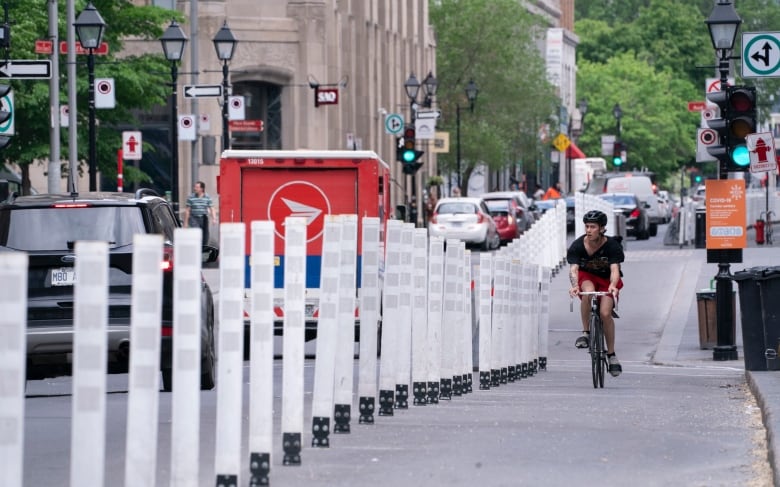Will the new bike boom last post-pandemic? Look to the '70s for clues, says writer
Cities across Canada extend temporary bike lanes as vehicle traffic drops due to COVID-19-related lockdowns


In February 1970, a group of students at San Jose State College in California bought a new Ford Maverick and then, they buried it in a 12-foot-deep hole.
It was reportedly a statement to declare the automobile dead and install the bicycle as the new dominant form of transportation, according to writer Carlton Reid.
"The U.S. secretary of transportation [John A. Volpe] was saying exactly the same thing: 'This is the end of the automobile age. We're going on to do different things,'" Reid, a transportation writer and contributing editor to Forbes, told Day 6 host Brent Bambury.
"So it really wasn't a wacky thing for those students to do when, you know, people at the top of the U.S. administration were absolutely saying the same thing."
Reid sees echoes of the 1970s American bike boom today, as demand for bicycles has skyrocketed thanks in part to concerns about crowded public transit and carpools during the COVID-19 pandemic.

But the '70s boom fizzled out after about four years — and the reasons behind it can serve as a warning, he said, for advocates who are hoping the momentary spotlight for the humble two-wheeler continues beyond the current era of lockdowns and physical distancing.
As Reid chronicled in an article for Forbes, cycling exploded in popularity in the early '70s. Bicycle sales averaged about six million a year back then, according to a Bank of America report. That increased to nine million in 1971 and 14 million in 1972, respectively.
Several factors contributed to the sales spike, Reid said, including a burgeoning health and fitness movement, the first Earth Day in 1970 and the fact that they were a relatively affordable "major" purchase for baby boomers, who were then mostly in their teens.
City of London’s not messing about. Some serious getting-rid-of-cars vibes. <a href="https://t.co/6nzhhPKIYX">pic.twitter.com/6nzhhPKIYX</a>
—@carltonreid"These baby boomers are now quite old but back then, they were whippersnappers — and they latched onto bikes," said Reid.
The movement also enjoyed a wave of political support — at least, for a time. The U.S. federal Department of the Interior committed to building 100,000 miles of bike lanes, and 252 bicycle-oriented bills introduced in 42 states were passed in 1973 alone.
Pedalling to the pandemic
Compared to the variety of factors that led to the '70s bike boom, you can trace just about every reason for the current sales spike to the pandemic and the summer season.
"It's come to a point where … everyone has realized we're running out. There are no bikes to go around anymore," said Amy Schweiger, assistant manager at Oxygen Bike Co. in Toronto.
"I think it mainly has to do with the fact that they all have way more time on their hands, and they're able to spend quality time with the people they care about and the people they're with," she said.
Thanks to travel bans and lockdowns keeping many people at home, cyclists are sharing the roads with fewer motor vehicles. Health officials have recommended outdoor activities, such as cycling and jogging — preferably alone or in small, physically-distancing groups — in lieu of indoor gatherings.
Several cities in Canada, from Montreal to Moncton, N.B., have also extended their cycling networks, carving out new bike lanes out of the now quieter roads.
According to Michael Longfield, interim executive director of the Cycle Toronto advocacy group, cities have a responsibility to make these changes permanent to make cities more livable.
"I think the pandemic is really just … exposing a lot of our weaknesses or gaps that we've maybe had as a culture and as a city," he told Spark host Nora Young.
"I think this pivoting to starting to address them, in this case with protected cycling infrastructure in the downtown and in the suburbs, is a really good first step to making this a longer-term change."
From bike boom to bust
Reid said, though, that unless action is taken to make these projects permanent, the current bike boom is at risk of fading away just like it did in the '70s.
"A hundred thousand miles of bikeways were promised across North America. Because they didn't actually appear, then there [was] nowhere for people to ride their bikes. And so they were put back into garages and then, they were forgotten about, unfortunately," he said.
Bike sales either reached an eventual saturation point, he said, or they simply fell out of fashion after a few years. As demand slowed, so did political will.

"At one point, it looked like maybe the USA would become as pro-cycling by some northern European countries. Obviously, as we know, that bike boom didn't last. It turned into a bust," Longfield said.
Reid pointed to some sections of London's famous Park Lane, which have erected concrete, rather than plastic barriers, to separate cyclists and drivers on the road.
"That is not going to disappear in three months' time. That's staying down. So motorists have lost that space on Park Lane and don't motorists know it," he said.
"You've got to build the infrastructure, and you've got to do it quickly."
Written by Jonathan Ore. Produced by Yamri Taddese with files from Adam Killick.
To hear more, download our podcast or click Listen above.
